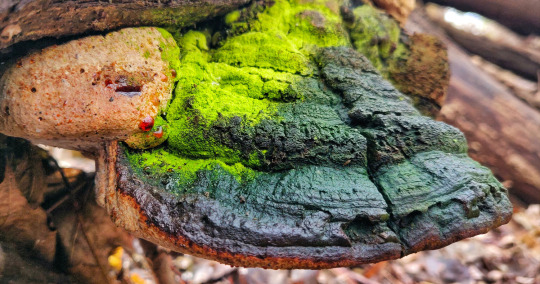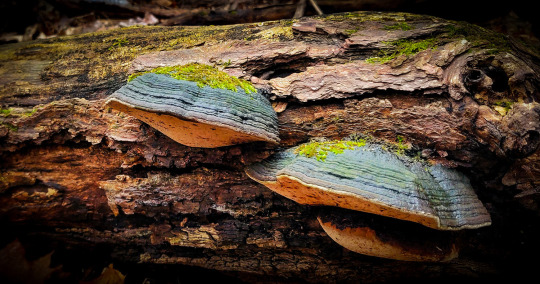#[phellinus robiniae]
Explore tagged Tumblr posts
Text
FOTD #035 : cracked cap polypore! (phellinus robiniae)
the cracked cap polypore (AKA cracked bracket & medicinal cracked cap polypore) is a parasitic bracket fungus in the family hymenochaetaceae. they occur in south africa, europe, canada, the US, mexico, costa rica, brazil, australia, kenya, zambia & zimbabwe !!
the big question : can i bite it?? this fungus is inedible (due to its toughness), but has medicinal uses.


p. robiniae description :
"this is one of a number of species with a hard, cracked fruit body. the cap is 3-36cm in diameter & 1,5-28cm thick. it is woody in texture, & has a greenish colour due to the algae that grows on its cap. the pores are yellow-orange."
[images : source & source] [fungus description : field guide to mushrooms & other fungi of south africa by gary b. goldman & marieka gryzenhout]
"these guys were my favourite for a looong time !! i really love them<;3"
#• fungus of the day !! •#[phellinus robiniae]#: cracked cap polypore :#: medicinal cracked cap polypore :#: cracked bracket :#035#||#fungus#fungi#mycology#cottagecore#foraging#earth#mushrooms#forestcore#mushroom#nature#fotd#fungus of the day
24 notes
·
View notes
Text



winter aconite (eranthis hyemalis,) a patch of cream violet (viola striata,) and some faraway cracked cap polypore (phellinus robiniae)
4 notes
·
View notes
Photo

This mushroom is bigger than my head. Its common name is “that shelf fungus that grows on black locusts”, and its scientific name is (Fulvifomes robiniae), but for a long time people usually called it (Phellinus robiniae), or sometimes other names. . . . #fungus #märchen #enchantedforest #polypore #fungi https://www.instagram.com/p/BvFpyh4BcNw/?utm_source=ig_tumblr_share&igshid=io6pqdaflqu7
32 notes
·
View notes
Photo



Phellinus robineae
Cracked locus conch, Orange pored locus bract fungi.
Growing on black locus, Robinia pseudoacacia, in Glenwood Gardens, Ohio
19 notes
·
View notes
Text
[VIDEO] Creating a Brick out of Mushrooms

via YouTube // Verge Science
Cement and concrete have been under the microscope for a number of years due to the amount of carbon created in the manufacturing process. There are many scientists throughout the world that are looking to crack the code on a new form of concrete-like material that has all of the benefits that concrete possesses. It’s a tall task, that’s why concrete has been used for hundreds of years. The latest example of scientific innovation comes from mushrooms.
Thanks to a video and an article from The Verge, we have an inside look at the process that was developed to make a brick made of mushrooms. By taking a small sample of a cracked cap polypore, a mushroom that you may know better by its Latin name – say it with me – Phellinus robiniae. The fungi grows on a black locust tree and is a hard mushroom, a property which would lead them to better success in the lab.
After finding one of these cracked cap polypores, the team cut off a small sample, placed even smaller samples into separate petri dishes, and waited for it to grow mycelium. Mycelium is kind of like the mushroom’s root system, which are small interwoven fibers that help with strength. Growing those fibers are the researcher’s path to creating the final brick.
Once the mycelium grown and become viable, it’s cut out of the petri dish and placed in a small jar of grains to grow for a week. After that, the mixture is moved into a larger container full of sawdust pellets and soybean hulls for another week. That final mixture is then placed in a brick mold to continue to strengthen for one more week. Lastly, the brick is baked for a few hours on low heat to stop the mushrooms from growing.
The total process to make one brick took over 4 weeks and the commercial viability of mushroom bricks is still in its infancy, but it is an interesting experiment to show how nature and building materials could eventually become intertwined…………like the mycelium – hold your applause.
Below is the video from The Verge, which shows the whole process of making and testing the brick. It also features one of my new favorite humans, William Padilla-Brown, who loves funghi more than you’ve ever loved anything. If you do nothing else in this world, find someone that looks at you the way William looks at a mushroom.
source https://www.constructionjunkie.com/blog/2021/2/4/video-creating-a-brick-out-of-mushrooms from G P NATIONAL CRANES LTD https://gpnationalcrane.blogspot.com/2021/02/video-creating-brick-out-of-mushrooms.html
0 notes
Photo




Phellinus robiniae -- “Cracked Cap Mushrooms”
Look at these bad boys! Whew! It is hard to explain how big they really are (up to 40 centimetres across) but there is one picture of my hand for comparison and this guy is WAAAY bigger! Wow! These were found in the wooded area on my parents property in Fisherville, Kentucky.
These mushrooms almost exclusively live on black locust trees, but can live on on others like oaks, hickories, and these that are probably living on a walnut. It is worth your time to go through different phellinus species if it isn’t on a black locust, just in case. Interestingly enough though, these mushrooms are such a common disease to black locust trees that most black locusts have at least one of these big guys on them.
These mushrooms are going to have a woody texture in both look and feel (and when you knock on it, it even sounds like wood!) on the top. And a it has a lighter brown, leathery texture on the bottom. It might be a little hard to tell from these particular pictures, but these mushrooms are polypores! Another distinct visual feature of these mushrooms is brown streaking down the tree under these mushrooms due to their spores. I think you can see some of this in the third picture.
Due to their woody nature, these mushrooms are generally inedible. These mushrooms are not poisonous, but I do not think you’d enjoy them too much.
0 notes